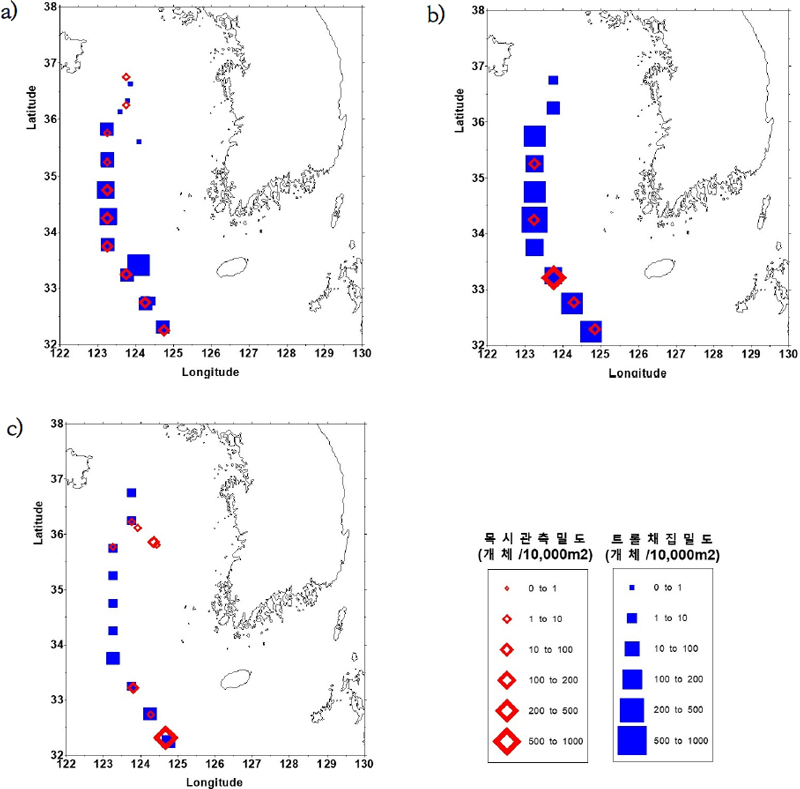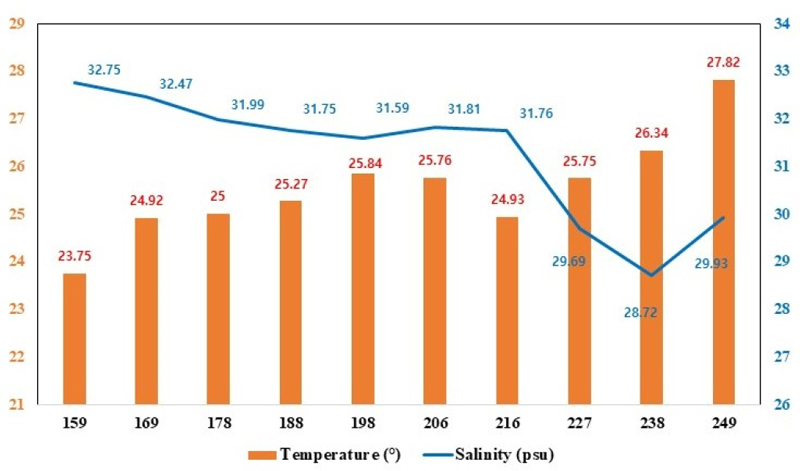
황해 중앙부와 동중국해 북부 해역에서의 대형 독성 노무라입깃해파리의 개체군 특성 연구
Ⓒ The Korean Environmental Sciences Society. All rights reserved.
This is an Open-Access article distributed under the terms of the Creative Commons Attribution Non-Commercial License (http://creativecommons.org/licenses/by-nc/3.0) which permits unrestricted non-commercial use, distribution, and reproduction in any medium, provided the original work is properly cited.
Abstract
The giant jellyfish, Nemopilema nomurai, is an endemic species found in Northeast Asian waters and their population structures, such as size and genetics, and their environmental characteristics were investigated. N. nomurai was obtained from the Yellow and Northern East China Seas during the summers of 2006, 2007, and 2009. In the northern Yellow Sea, small-sized jellyfish were found to be dominant and towards the southern seas, the size of the jellyfish increased. In the northern East China Sea, only one mode of jellyfish was found in May, and the number of modes increased up-to five in July. However, at the center of the Yellow Sea, one or two modes were found in July, 2007. Thus, different jellyfish populations were present in the northern East China Sea and the Yellow Sea. However, based on first appearance and a cohort analysis using the bell diameter, the jellyfish population in the northern Yellow Sea might be recognized as a distinct group that differed from those found in the northern East China Sea. Furthermore, mitochondrial DNA sequences (cytochrome c oxidase subunit I) of N. nomurai were, determined and compared with genetic structures obtained from jellyfish in the Yellow Sea. The genetic diversity of N. nomurai was highest in the regions around the northern East China Sea and at the center of the Yellow Sea and was the lowest around the northern Yellow Sea. Thus, N. nomurai populations in the Yellow Sea and northern East China Sea might be different concerning their seeding places.
Keywords:
Giant jellyfish, Nemopilema nomurai, Population structure, Genetics1. 서 론
노무라입깃해파리는 동중국해와 황해에서 자생하는 우산의 크기가 2 m가 넘고, 무게가 200 kg에 달하는 대형 독성해파리로(Omori and Kitamura, 2004; Park and Chang, 2006)(Fig.1.), 과거에도 한국, 중국, 일본 등 동아시아 북부에서 출현한 기록이 있으나, 2003년 이후에 대량 발생하여 수산업 및 대중 건강에 피해를 끼쳤다(Uye, 2008; MLTM, 2009). 국립수산과학원에서는 2004년부터 한국해역에 출현하는 노무라입깃해파리 분포와 이동 특성을 조사한 바 있다(Yoon et al., 2014).
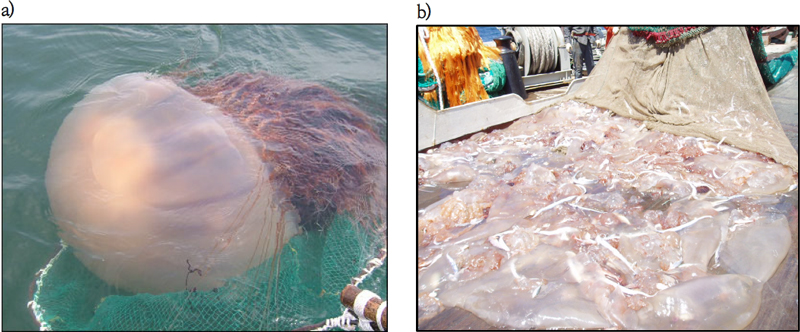
a) Whole body of Nemopilema nomurai, ca. 150 cm, b) Damaged caused by a mixture of jellyfish and fish.
노무라입깃해파리는 동중국해 북부에서 5월부터 출현하고, 황해와 한국 해역에서 6월과 7월에 발견되며, 8월에는 동중국해 보다 황해 북동쪽이나 대한 해협과 동해의 남서쪽에서 출현한 후, 10월에는 우리나라 전역에서 확인되나 출현밀도가 감소한다(Yoon et al., 2014)(Fig. 2). 즉 동중국해 북부해역에서 기원한 노무라입깃해파리가 양자강수와 쿠로시오해류의 지류인 대마난류를 타고 이동하여 동북아시아 전역으로 확산되는 패턴이 기록되었다(Moon et al., 2010).
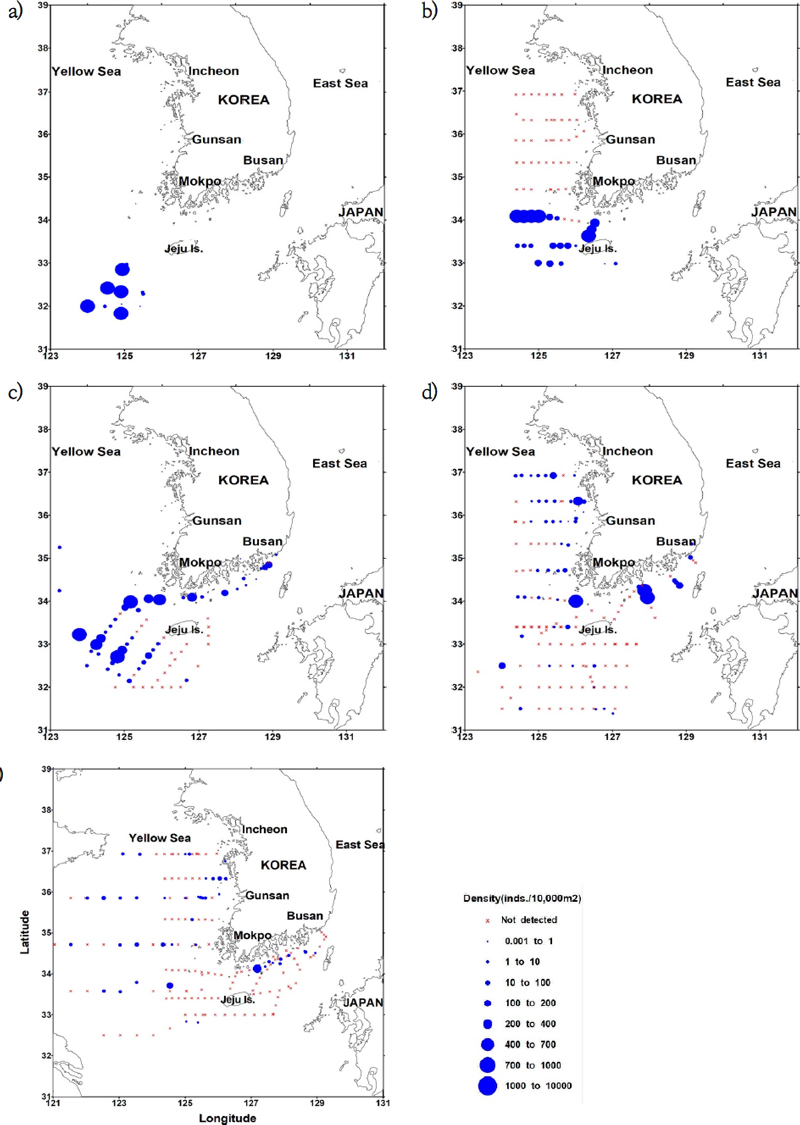
Spatio-temporal distribution pattern of Nemopilema nomurai in Korean waters. Red points indicate observation station and absence of jellyfish. Blue points indicate stations at which jellyfish were found, and the size of point corresponds to the density. a) May, b) June, c) July, d) August, e) October in 2007.
부유형 해파리는 알과 정자가 만나 유성생식을 하고, 플라뉼라(planula) 유생이 바닥에 부착하고, 저서형 폴립과 포도시스트(podocyst)를 형성하여 무성생식을하며 개체 수를 늘리는 생태특성을 가진다(Kawahara et al., 2006). 노무라입깃해파리의 저서형태인 폴립을 찾기 위해 한국, 중국, 일본 연구자들은 다 년간 노력했다. 그러나 자연상태의 폴립은 발견하지 못했고, 부유 생활사의 초기 단계인 에피라를 동중국해와 황해에서관찰한 바 있다(Dong et al., 2018). 하지만, 황해 중앙부와 동중국해에서 출현하는 개체군들에 대한 생물학적 생태학적 연구는 수행하지 못하였다.
이번 연구에서는 노무라입깃해파리의 초기 출현, 분포 양상, 개체군 구조, 유전적 구조 등 생물학적 특성을 바탕으로 발생지로 여겨지는 동중국해 북부와 황해에서 개체군 구조의 발생 특성을 체장 조성과 미토콘드리아 유전자로 심층 분석하고자 한다.
2. 재료 및 방법
2.1. 해파리 조사 지역 및 채집
해파리 조사는 국립수산과학원 탐구1호와 20호에 승선하여 한중 잠정조치수역(EEZ) 자원조사와 병행하여 159해구~149해구에서 수행하였다(Fig. 3, Table 1.). 자원조사를 할 때 해파리 조사를 병행하였고, 이번 조사 결과는 2006년 7월 27일~8월 1일, 2007년 7월 27일~31일, 2009년 8월 6일~14일에 수행한 조사 결과이다. 노무라입깃해파리 분포조사를 표층에 출현하는 해파리를 대상으로 목시조사로 수행하였는데, 조사 방법은 Yoon et al.(2008) 방법을 따랐다. 자세히 설명하면 목시조사는 조사선이 일정 속도로 운항 할 때, 조사선의 선체 위에서 5-10분 동안 5-10 m 내의 시야에 들어오는 해파리를 측정하였다. 조사 시간과 선속으로 이동 거리를 계산하여, 조사 시야를 곱하여 조사 면적을 구하였고(조사 면적: 선속(knot) x 조사 시간(min.) x (1852/60 min.) x 조사 시야(m)), 면적 당 개체수로 환산하였다.

Sampling station in Korea-China Exclusive Economic Zone (EEZ) in Yellow Sea, Latitude/Longitude and Date
중층과 저층에 분포하는 해파리는 트롤을 이용하여 채집하였다. 트롤어구에 트롤아이를 장착하여 망구 폭을 측정하고, 예망거리를 바탕으로 소해 면적(망구폭 x 예망거리)을 구하였고, 예망거리(m) 와 망구면적(m2)을 바탕으로 소해 용적(망구면적 x 예망거리, m3)을 구하였다. 전체 채집된 해파리 개체수를 바탕으로 출현 밀도를 구하였다.
2.2. 해파리 체장 조성 측정
2006년 7월 노무라입깃해파리 전체 1,560개체를 채집하였고, 체장 측정은 461개체에 대하여 우산 직경을 측정하였다. 2007년 7월과 2009년 8월의 체장 측정은 각각 전체 채집 14,818개체 중 899개체와 1,011개체 중 512개체에 대하여 실시하였다. 체장 조성을 바탕으로 동시대에 출생하였을 것으로 여겨지는 개체군의 연급군(cohort)을 분석하였다(Bhattacharya, 1967). 해양환경 특성을 조사하기 위하여 CTD(SeaBird 911)로 수층별 수온, 염분을 연속 측정하였다.
2.3. 해파리 유전자 분석
유전자 분석은 2007년과 2009년에 채집한 해파리로 각각 실시하였다. 여기서 2007년 7월에 채집한 노무라입깃해파리 106개체의 유전자를 분석하였다. 7월 황해 15개체, 7월 황해 중앙부 42개체, 동중국해 5월 19개체, 7월에 30개체를 분석하였다.
2009년 8월에 3개 정점인 황해 26개체, 황해 중앙부 25개체, 동중국해 26개체로 총 77개체에 대한 유전자를 분석하였다.
유전자 분석은 해파리 우산 조직을 잘라서 99% 에탄올에 고정하여 에탄올과 동물플랑크톤 등 불순물을 제거한 후, Asahida et al.(1996)의 방법으로 유전자를 추출하였다. 개체군 구조 특성은 미토콘드리아 COI(Cytochrome oxidase I) 유전자의 일부분(534 bp)를 증폭하여 분석하였다. 이번 연구에 활용된 프라이머는 HCO2198 (5′-TAA ACT TCA GGG TGA CCA AAA AAT CA-3′), LCO 1490 (5′-GGT CAA CAA ATC ATA AAG ATA TTG G-3′) (Folmer et al., 1994)을 이용하였다. 유전자증폭기(Biometra, Göttingen, Germany)는 30 사이클 (94°C 8분, 49°C 2분, 72°C 2분, 94°C 4분, 50°C 2분, and 72°C 2분), 33 사이클(94°C 45초, 51°C 45초, 72°C 60초)을 증폭하였다. 마지막은 확장과정에서 72°C 10분 마무리하고 4°C를 유지하였다. 증폭된 유전자를 정제하여 자동 유전자 분석기(ABI 3730Xl; Applied Biosystems, Foster City, CA, USA)에서 염기서열을 분석하였다. 염기서열은 MEGA 7 (Kumar et al., 2016) 소프트웨어로 정렬하여 유전자형을 확인하였다.
3. 결과 및 고찰
3.1. 황해 위도별 해파리 관측 밀도 특성
본 연구에서 수행된 목시 관측 결과에 따르면, 2006년 7월 27일~8월 1일 조사에서 노무라입깃해파리가 평균 50.41 개체/10,000 m2 출현하였다. 2007년 7월 27일~31일 조사에서는 노무라입깃해파리 312.62 개체/10,000 m2, 2009년 8월 6일~14일에 수행한 조사에서는 80.81 개체/10,000 m2의 밀도로 조사되었다. 황해 중앙부 동중국해 북부 10개 정점의 해파리 출현밀도를 비교할 때, 2007년 출현밀도가 가장 높았고, 2009년, 2006년도 순으로 나타났다(Fig. 4). 트롤 채집밀도 분석결과, 2006년에는 평균 13.99 개체/10,000m2, 2007년에는 221.49 개체/10,000 m2, 2009년에는 12.70 개체/10,000 m2로 목시 관측결과와 유사하게 2007년에 채집밀도가 가장 높았다(Fig. 4). 반면에 요동반도에서는 2006년 출현밀도가 가장 높았고, 그 다음으로 2007년, 2009년 순으로 출현밀도가 낮았다. 따라서, 출현양상은 동중국해와 황해 북부 요동반도 출현 간에는 차이가 나타났다(Dong et al., 2018).
3.2. 황해 노무라입깃해파리 체장 조성
체장 평균은 2006년 39.15 cm, 2007년 29.95 cm, 2009년 60.53 cm으로 2007년 것이 가장 낮았으나, 출현밀도는 312.62 개체/10,000 m2로 오히려 가장 높게 나타났다(Fig. 5). 이러한 2007년의 현황은 먹이생물 포식압이 높아짐과 함께 성장률이 둔화된 것과 관계가 있는 것으로 판단된다(Kitajima et al., 2020).
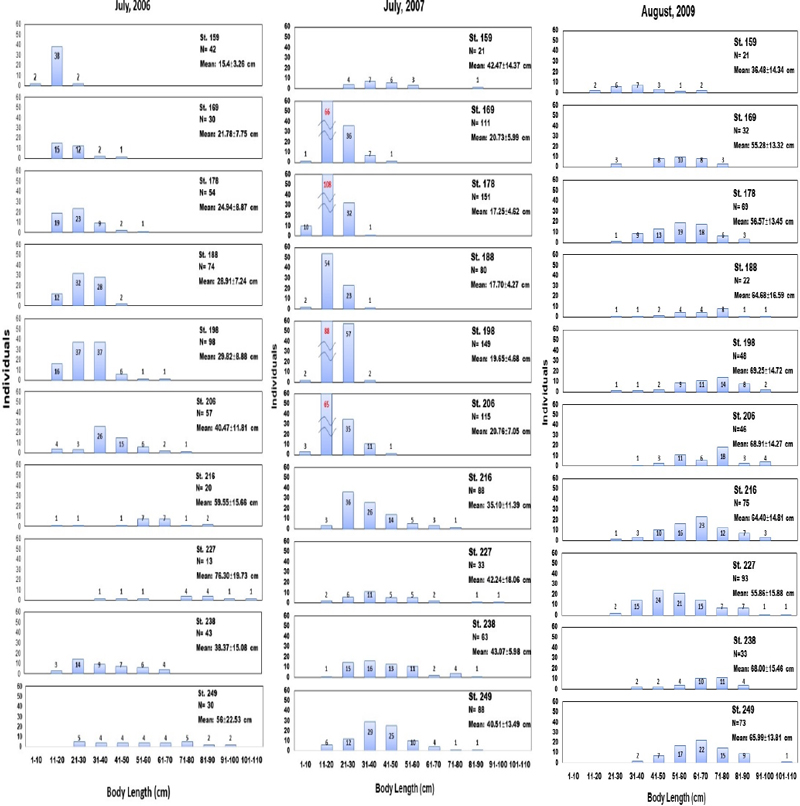
Histograms of the bell diameter of Nemopilema nomurai in the Yellow Sea. a) July, 2006, b) July, 2007, c) August, 2009.
2006년 7월 위도별 노무라입깃해파리 체장조성은 고위도에 있는 159해구의 경우 체장 범위는 5~30 cm로 평균은 15.4 cm이었다. 그러나, 저위도로 갈수록 체장 평균은 증가하여, 227해구에서 채집된 해파리의 체장 평균은 76 cm까지 증가하였다(Fig. 5a). 이때, 표층 수온은 159해구에서 23.75℃, 227 해구가 25.75℃로 저위도에서 2℃ 높았다(Fig. 6).
2007년 5월 동중국해 북부에서 채집된 개체들은 2.5-20 cm로 1개의 연급군만으로 구성되어 있었다(Yoon et al., 2014). 하지만, 2007년 7월 동중국해 북부에서 채집한 해파리는 10-90 cm의 체장 범위를 나타냈고, 평균은 40.51 cm로, 발생한지 2개월 이상 되는 개체를 포함하여 4개 이상의 연급군이 확인되었다(Fig. 5b). 황해 중앙부(해구178~198)는 1개의 연급군만 확인되었고, 체장 평균은 20 cm 이하로 출현 시기가 동중국해 보다 늦었다(Fig. 5b).
노무라입깃해파리는 동중국해 양자강 유역에서 에피라가 발견된 적이 있기에(Toyokawa et al., 2012). 양자강 유역이 노무라입깃해파리의 발생지 부근이라는 기록을 이번 연구결과도 뒷받침할 수 있다. 요동반도에서도 3~20 cm의 유생이 출현한 기록이 있고(Dong et al., 2018), 이번 연구결과에서도 10 cm 이하의 노무라입깃해파리가 확인되었으므로 황해 북부해역도 노무라입깃해파리 발생지와 가깝게 있는 것으로 판단되지만, 발생시기는 위도와 수온에 따라서 약 2달 가량 차이가 나는 것을 이번 조사에서 확인하였다. 황해 북부의 수온과 황해 남부, 동중국해역의 수온차이가 약 2~4℃ 가량 차이가 났으며 이는 발생시기의 차이에 영향을 미친 것으로 판단된다. 노무라입깃해파리와 동일한 근구해파리목에 속하는 기수식용해파리의 경우에 발생지는 무안 연안(위도 35°)과 강화도 연안(위도 38°)인 것으로 밝혀졌다. 무안 연안의 기수식용해파리 개체군은 6월에 출현하기 시작하였으나, 강화 연안 개체군은 8월에 출현하기 시작하였다. 이때 무안과 강화의 8월 수온 차이는 약 4℃ 차이가 나타났다(Chang et al., 2023). 조사 정점별 해파리 체장의 차이는 기원지에서의 멀고 가까움과 발생 후의 시간경과에 기인하는 것으로 추정되나, 수온이 먼저 증가하는 남쪽에 발생지를 둔 해파리 개체군들의 출현시기가 빠른 것을 2종의 근구해파리를 통해 확인할 수 있다.
7월 이전에 발생한 개체군들이 황해 내에서 출현시기와 출현하는 위도가 달라서 분리되지만, 8월에는 동중국해에서 올라온 개체들과 요동반도에서 내려온 개체들이 황해 중앙부에서 섞일 가능성이 있다. 황해는 반폐쇄성 만의 특성상 해파리가 축척 되고, 대한해협을 통과한 해파리는 동해에서 사멸하게 되는 특성을 보인다(Yoon et al., 2014).
3.3. 황해 및 동중국해 노무라입깃해파리 개체군의 유전적 다양성
2007년 7월 황해 15개체 중에 유전자형 6개, 7월 황해 중앙부 42개체 중에 유전자형 15개, 동중국해 5월 19개체 중에 유전자형 10개, 7월 30개체 중에 유전자형 15개가 확인되었다(Fig. 7a). 또한 2009년 8월 황해 26개체 중에 유전자형은 9개, 황해 중앙부 25개체 중에 유전자형은 12개, 동중국해 26개체 중에 유전자형은 9개가 확인되었다(Fig. 7b)
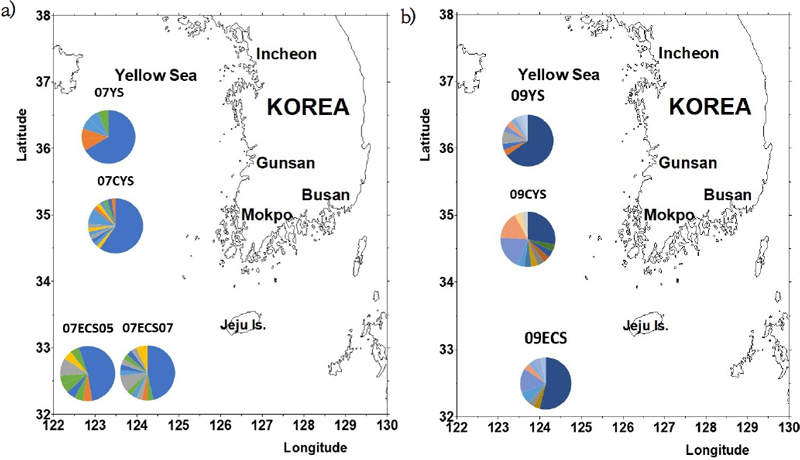
Genetic diversity of Nemopilema nomurai based on mitochondrial cytochrome c oxidase subunit I DNA in 2007 (a) and 2009 (b) in the Yellow Sea. Yellow Sea (YS, St. 159, 169), Center of Yellow Sea (CYS, St. 206), and ECS (East China Sea, St. 249).
2007년 5월 동중국해에서 10개의 유전자형이 확인되었으나, 7월에는 15개가 확인되었으며, 해당 결과는 발생하는 개체가 늘어나면서 유전적 다양성도 높아지는 것을 확인할 수 있다. 유전자 분석결과도 체장 조성과 유사하게 동중국해는 다양성이 높았고, 황해 중앙부는 다양성이 낮았다(Fig. 7a).
2009년 8월에는 황해 중앙부의 유전자형이 가장 많았는데, 발생한 개체들이 늘어나면서, 동중국해에서 발생한 개체들은 황해 중앙부로 유입되고, 황해에서 발생한 개체들도 혼합되면서 다양한 개체군들이 황해 중앙부에 모이는 것으로 여겨지는데, 향후 지역간 그룹의 분화를 분석하며 심층 분석이 필요하다.
4. 결 론
노무라입깃해파리는 동북아시아지역(한국, 중국, 일본)에 출현하는 자생종으로, 동중국해와 황해가 발생지라는 추측이 있었다. 이번 연구에서 황해 중앙부와 동중국해북부에 출현하는 노무라입깃해파리의 2006년, 2007년과 2009년 하계 최초 출현시기 분포, 체장 조성을 바탕으로 한 개체군 구조와 유전적 구조 분석결과를 확인했다. 황해 남부에 노무라입깃해파리 집단의 7월 체장평균은 60 cm 이상으로 동일한 시기에 발생한 연급군이 5개까지 확인되었고, 발생한지 2달 가량된 개체들이었다. 황해 북부 개체군의 체장 평균은 약 20~30cm로 연급군이 1~2개 확인되는 등 발생한지 1달 내외의 개체군들이었다. 2007년과 2009년 7월에 채집한 노무라입깃해파리의 유전적 구조를 확인했을 때 다양한 연급군이 나타나는 동중국해의 유전적 다양성이 높았고, 황해 북부 개체군의 유전적 다양성이 낮았다. 황해 북부 개체군과 남부에 출현하는 개체군들의 발생시기는 1달 이상 차이가 나는 것으로 여겨지며 발생지도 분리되어 있는 것으로 여겨진다. 향후 요동반도에 출현하는 노무라입깃해파리를 포함하여 지역별 개체군의 심층적인 유전자 분석이 필요한 것으로 판단된다.
Acknowledgments
이번 연구는 국립수산과학원의 연안어장환경조사 및 변동 연구(R2024014)의 지원을 받아 수행하였습니다.
REFERENCES
-
Asahida, T., Kobayashi, T., Saitoh, K., Nakayama, I., 1996, Tissue preservation and total DNA extraction from fish stored at ambient temperature using buffers containing high concentration of urea, Fisheries Science, 62, 727-730.
[https://doi.org/10.2331/fishsci.62.727]

-
Bhattacharya, C. G., 1967, A Simple method of resolution of a distribution into Gaussian components, Biometrics, 115-135.
[https://doi.org/10.2307/2528285]

- Chang, S. J., Ki, J. S., Yoon, W. D., Jun, G. E., 2023, Genetic Structure of the Jellyfish Rhopilema esculentum (Scyphozoa: Rhizostomatidae) in Korean Coastal Waters, Anim. Syst. Evol. Divers., 39(4), 264-271.
-
Dong, J., Wang, B., Duan, Y., Yoon, W. D., Wang, A., Liu, X., Chai, Y., 2018, Initial occurrence, ontogenic distribution-shifts and advection of Nemopilema nomurai (Scyphozoa: Rhizostomeae) in Liaodong Bay, China, from 2005-2015, Marine Ecology Progress Series, 591, 185-197.
[https://doi.org/10.3354/meps12272]

- Folmer, O., Black, M., Hoeh, W., Lutz, R., Vrijenhoek, R., 1994, DNA primers for amplification of mitochondrial cytochrome c oxidase subunit I from diverse metazoan invertebrates, Molecular Marine Biology and Biotechnology, 3, 294-299.
-
Kawahara, M., Uye, S. I., Ohtsu, K., Iizumi, H., 2006, Unusual population explosion of the giant jellyfish Nemopilema nomurai (Scyphozoa: Rhizostomeae) in East Asian waters, Marine Ecology Progress Series, 307, 161-173.
[https://doi.org/10.3354/meps307161]

-
Kitajima, S., Hasegawa, T., Nishiuchi, K., Kiyomoto, Y., Taneda, T., Yamada, H., 2020, Temporal fluctuations in abundance and size of the giant jellyfish Nemopilema nomurai medusae in the northern East China Sea, 2006–2017, Marine Biology, 167(6), 75.
[https://doi.org/10.1007/s00227-020-03682-1]

-
Kumar, S., Stecher, G., Tamura, K., 2016, MEGA7: molecular evolutionary genetics analysis version 7.0 for bigger datasets, Molecular Biology and Evolution, 33, 1870-1874.
[https://doi.org/10.1093/molbev/msw054]

- MLTM (Ministry of Land, Transport and Maritime affairs, ROK), 2009, Preventing damages form harmful jellyfish, 225.
-
Moon, J. H., Pang, I. C., Yang, J. Y., Yoon, W. D., 2010, Behavior of the giant jellyfish Nemopilema nomurai in the East China Sea and East/Japan Sea during the summer of 2005: a numerical model approach using a particle-tracking experiment, Journal of Marine Systems, 80(1), 101-114.
[https://doi.org/10.1016/j.jmarsys.2009.10.015]

- Omori, M., Kitamura, M., 2004, Taxonomic review of three Japanese species of edible jellyfish (Scyphozoa: Rhizostomeae), Plankton Biology and Ecology, 51(1), 36-51.
- Park, J. H., Chang, S. J., 2006, Three new records of scyphomedusae (Cnidaria: Scyphozoa) in Korea, Animal Systematics, Evolution and Diversity, 22(1), 57-62.
-
Toyokawa, M., Shibata, M., Cheng, J. H., Li, H. Y., Ling, J. Z., Lin, N., Akiyama, H., 2012, First record of wild ephyrae of the giant jellyfish Nemopilema nomurai, Fisheries Science, 78, 1213-1218.
[https://doi.org/10.1007/s12562-012-0550-0]

-
Uye, S. I., 2008, Blooms of the giant jellyfish Nemopilema nomurai: a threat to the fisheries sustainability of the East Asian Marginal Seas, Plankton and Benthos Research, 3(Supplement), 125-131.
[https://doi.org/10.3800/pbr.3.125]

-
Yoon, W. D., Yang, J. Y., Shim, M. B., Kang, H. K., 2008, Physical processes influencing the occurrence of the giant jellyfish Nemopilema nomurai (Scyphozoa: Rhizostomeae) around Jeju Island, Korea, Journal of plankton research, 30(3), 251-260.
[https://doi.org/10.1093/plankt/fbm102]

-
Yoon, W. D., Lee, H. E., Han, C., Chang, S. J., Lee, K., 2014, Abundance and distribution of Nemopilema nomurai (Scyphozoa, Rhizostomeae), in Korean waters in 2005–2013, Ocean Science Journal, 49, 183-192.
[https://doi.org/10.1007/s12601-014-0018-5]

Marine Environment Impact Assessment Center, National Institute of Fisheries Sciencesjchang7@korea.kr
Department of Life Sciences, Sangmyung Universitykijs@smu.ac.kr

